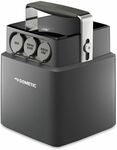This retails at $1199. Most stores have dropped it to $999 at the moment. Except for Snowys who are advertising this for $899. Cheapest I have ever seen it.
So here’s the deal, go to Anaconda (who as of today have a 20% off sale and are selling for $929) and request a price beat and they will sell it to you for $809. Absolute steal.




Bloody expensive glorified battery.
Btw it's not Lithium it's a LiFePo4.. (Lithium Iron Phosphate).
40 Amps won't last long unless U only use it for charging phones etc..